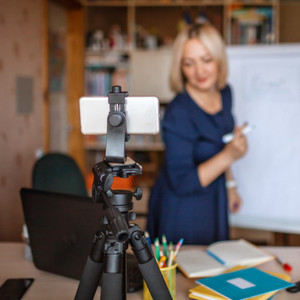Flexible Lesson Plans for the Hybrid Classroom
A key component of hybrid classrooms are flexible lesson plans. Why? Because hybrid classrooms cannot be treated like in-person classes, where students have more physical interactions with their peers and teachers and are able to pay attention to social cues and/or body language. In a traditional in-person classroom, many social aspects of teaching and learning can be taken for granted. All this changes in a hybrid, blended learning environment.
In a hybrid classroom, students cannot just rely on standard instruction from their teachers; they also learn from podcasts, guest speakers, teaching videos, and interactions with peers in breakout rooms. In a hybrid learning space, teachers and students learn to access the innumerable possibilities that technology offers to bridge the gaps in time and space. Here are some ideas to consider when planning a hybrid lesson plan. We’ve focused specifically on Google Classroom but the concepts can be used with any LMS:
Delivery
Consider the delivery of lesson content that has been repurposed for an online classroom. A teacher presents information about cyberbullying, its definition, signs, and ways to respond to it. The teacher makes a PowerPoint presentation.
In order to make the repurposed lesson flexible so that students can study without interruptions regardless of their physical location, the teacher may consider the following:
Leading the lesson from the classroom, or remotely via Google Meet. Students at home can log in online and students in an in-person classroom can watch the projected PowerPoint lesson that illustrates the lesson content on a screen or view the presentation live. Students logging into the class online can be asked to turn on their videos so that their teacher can see their responses while teaching. If a teacher is providing instruction remotely, a classroom camera facing the students in the in-person classroom can help the teacher to keep track of their students’ responses. No matter where they’re physically located, students can ask and respond to questions via chat or voice calls.
Engagement
To enable students in a hybrid classroom to discuss and respond to case studies in a group activity, a teacher may wonder, “How can students who are online collaborate with students in an in-person classroom?”
To enable flexible engagement, a teacher may set up a Google Slides slideshow for students studying online with one slide for each case study, and ask each student to write their thoughts and comments under the scenarios. They can encourage further engagement by asking the students to comment on their peers’ remarks and suggestions. Teachers can also ask students in the in-person classroom to log into the school devices to access the same Google slideshow and participate in the class discussion.
Teachers may also use the same Google Slideshow to display case studies on a projected screen in the in-person classroom. They may enable their online students to participate in the live presentation and discussion via Google Meet.
Such flexibility enables teachers to facilitate healthy, participative classroom discussions regardless of their students’ (or their own) physical location.
Assessment
Teachers can create a variety of assessment options in a hybrid classroom. For example, while teaching a lesson on cyberbullying, teachers may ask their students to write an article on the topic as part of their assessment.
On Google Classroom, a teacher can create an assignment with assessment, receive submitted work from students, review and respond to the submissions with feedback, and grade their students’ work. Students may enter all their submissions directly into Google Classroom. This is also an excellent option for students in an in-person classroom, who may choose to submit their assignments either online or physically to their teacher who may then enter their grades online. Students who study remotely but prefer writing their assignments by hand can upload its pictures on Google Classroom or send audio notes via Gmail.
A hybrid classroom is a truly inclusive classroom, with space for remote, asynchronous, in-person, and synchronous learners.
 About the Author
About the Author
Ellen Paxton is a respected expert in education and best known as the Chief Learning Officer of Professional Learning Board. As a two-time National Board Certified Teacher, Ellen has successfully published and customized online professional development courses and Learning Management Systems for 20 years to help teachers meet their state continuing education renewal credit requirements. Through ProfessionalLearningBoard.com, RenewaTeachingLicense.com, and ConnectedPD.com. Ellen has established solutions and maintained partnerships with several accredited universities, higher education institutions, teachers’ unions and state Departments of Education while setting strategic direction that makes a difference and overseeing implementation of popular online PD.

Comments are closed.